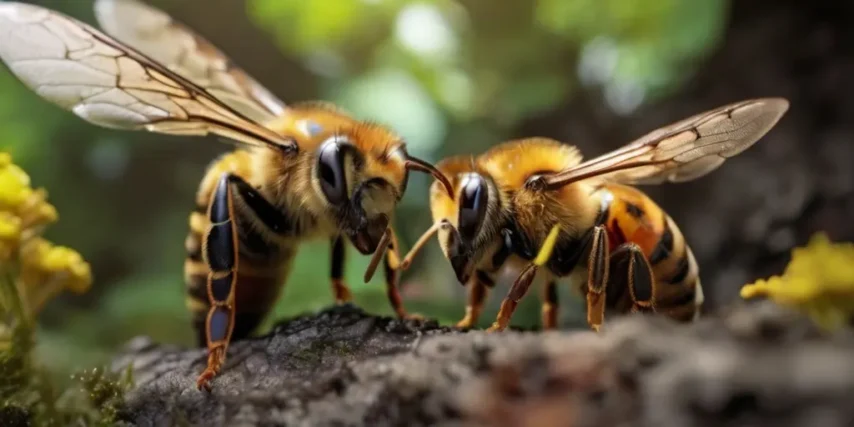Buzzing Battle: Unveiling the Fascinating Contrast Between Bees and Wasps
Introduction:
In the intricate tapestry of the insect world, bees and wasps stand out as prominent characters, often causing curiosity and sometimes fear among humans. Despite their similar appearance and shared membership in the order Hymenoptera, these buzzing creatures possess distinct characteristics, behaviors, and ecological roles. Embark with us on a journey of discovery as we delve deep into the nuanced differences between bees and wasps, unraveling their mysteries and shedding light on their unique contributions to the natural world.
Anatomy and Morphology:
At first glance, bees and wasps may appear indistinguishable, with their slender bodies, vibrant hues, and unmistakable buzzing flight patterns. However, a closer examination reveals subtle disparities in their anatomical features. Bees typically boast stout, robust bodies adorned with branched body hairs, facilitating pollen collection—a vital task in their role as pollinators. Conversely, wasps exhibit sleeker physiques with smooth bodies, often adorned with vivid stripes or patterns, serving as warning signals to potential predators.

Social Structure:
One of the most striking differentiators between bees and wasps lies in their social organization. Bees are renowned for their intricate hive structures and highly organized societies, characterized by caste systems comprising queens, workers, and drones. These industrious insects work tirelessly to sustain their colonies, with each member fulfilling a specialized role in tasks such as foraging, nursing, and hive maintenance. In contrast, most wasp species adopt a solitary lifestyle, with only a few species forming small colonies. Queens lay eggs that develop into independent workers, each responsible for provisioning and guarding its own nest.
Feeding Habits:
While both bees and wasps exhibit a penchant for nectar, their dietary preferences diverge significantly. Bees, as pollinators, primarily feed on nectar and pollen obtained from flowers—a symbiotic relationship crucial for plant reproduction. Their foraging activities inadvertently facilitate the cross-pollination of various plant species, thereby contributing to ecosystem diversity and stability. In contrast, wasps exhibit carnivorous tendencies, preying on a variety of insects, spiders, and even carrion to nourish themselves and provision their developing larvae. This predatory behavior often earns wasps a reputation as aggressive hunters, contrasting sharply with the more docile demeanor of bees.

Reproductive Strategies:
The reproductive strategies employed by bees and wasps underscore their evolutionary adaptations to diverse ecological niches. Bees rely on intricate mating rituals within their colonies, with queens engaging in nuptial flights to mate with multiple drones from neighboring hives—a phenomenon essential for maintaining genetic diversity within the population. Fertilized queens then establish new colonies by constructing elaborate wax combs and laying eggs, perpetuating the cycle of life. Conversely, solitary wasps exhibit a more solitary approach to reproduction, with females constructing individual nests for oviposition. These nests may vary in structure, ranging from mud tubes to burrows in the ground, each tailored to the specific requirements of the species.
Ecological Significance:
Despite their contrasting lifestyles, both bees and wasps play crucial roles in ecosystem dynamics, exerting profound influences on plant pollination, pest control, and nutrient cycling. Bees, as primary pollinators, facilitate the reproduction of numerous flowering plants, including many agricultural crops essential for human sustenance. Their pivotal role in crop production underscores the significance of conserving bee populations amidst global concerns over pollinator declines. Similarly, wasps contribute to pest management by preying on a variety of insect pests, thus helping to regulate populations and maintain ecological balance.

Interactions with Humans:
The interactions between humans and bees and wasps have yielded a complex tapestry of emotions, ranging from admiration to apprehension. Bees, celebrated for their honey production and pollination services, have long been revered in various cultures as symbols of industriousness, cooperation, and fertility. However, their stingers and swarming behavior also evoke fear and anxiety in those unfamiliar with their gentle nature. Conversely, wasps, with their predatory instincts and defensive stings, often provoke fear and aversion, leading to widespread misconceptions about their ecological significance and value.
In conclusion, the dichotomy between bees and wasps exemplifies the remarkable diversity and complexity of the natural world. While superficially similar, these two groups of insects have evolved distinct adaptations and behaviors in response to their ecological niches. By understanding and appreciating the unique attributes of bees and wasps, we can foster greater respect for these fascinating creatures and cultivate a deeper appreciation for the interconnectedness of life on Earth. As stewards of the environment, it behooves us to recognize the vital roles played by bees and wasps in sustaining ecosystems and to strive towards their conservation and coexistence.
With their intricate behaviors, vibrant colors, and ecological significance, bees and wasps continue to captivate the imaginations of scientists, naturalists, and enthusiasts alike, serving as ambassadors for the rich tapestry of life that surrounds us. As we navigate the complexities of the natural world, may we embrace the diversity of life forms that share our planet and work together to safeguard their future for generations to come.







